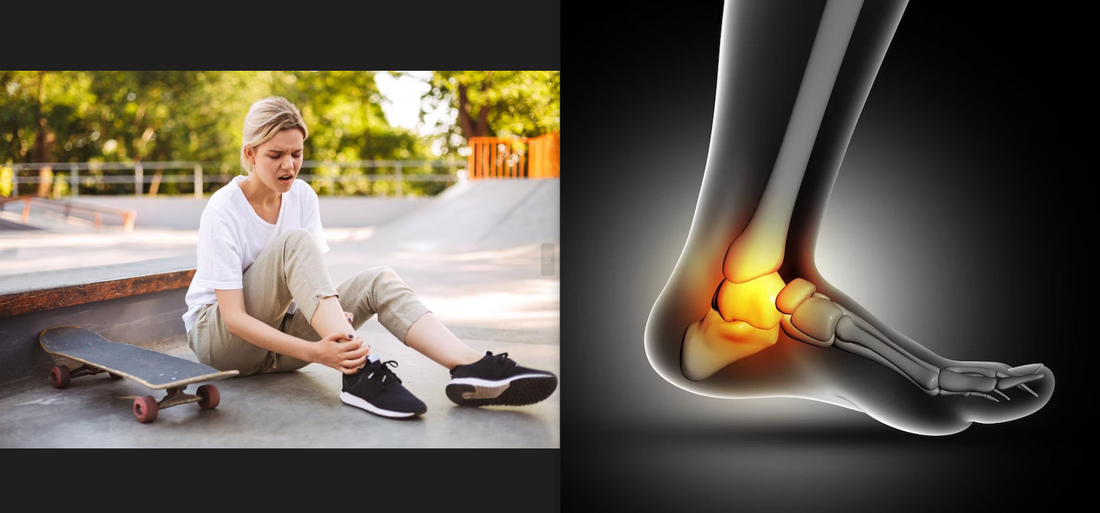
Heel spur vs. Plantar Fasciitis. Understanding the difference
Share
Painful plantar heel is a relatively common clinical entity encountered by the healthcare professional who treats patients with foot complaints. It refers to the discomfort and pain experienced in the bottom of the foot, specifically the heel region. Plantar fasciitis and calcaneal spurs are frequently associated with this condition, but understanding the differences between them can be challenging.
Distinguishing between plantar fasciitis and calcaneal spurs can be challenging because they often coexist and share similar symptoms.
It's important to seek professional medical advice if you're experiencing persistent heel pain. A healthcare professional can assess your symptoms, perform a physical examination, and recommend appropriate treatment options tailored to your specific condition. With proper management, most individuals can find relief from their painful plantar heel and regain normal foot function.
Plantar fasciitis (PF) is the most common cause of chronic pain beneath the heel in adults. It is the inflammation of the thick fibrous band of tissue (fascia) that runs along the bottom of the foot. This tissue acts as a shock absorber and it is responsible to maintain the arch of the foot.

PF can occur in case of faulty foot mechanics, improper shoe wear, exercise overload, excessive weight and diseases such as diabetes. Besides morning stiffness and tenderness on the sole of the foot, variable pain also in the sole is usually felt. It tends to be worse after rest and at night after a lot of activity, which can lead to a time break in participating in sports.
A heel/calcaneal spur is an abnormal bony outgrowth on the heel bone that can appear at the back of the heel or under the sole, the last one being more common.
It appears due to excessive stress, compression and pressure applied to the calcaneus by the plantar fascia and intrinsic muscles, developing an ossification as a protective mechanism. This stress can be caused by excessive weight, foot posture, professions requiring long standing hours, using repetitively high heels or as a reaction to plantar fasciitis.
In Spite heel pain being one of the most common foot problems, calcaneal spurs are not the main reason for it, since most times they are asymptomatic. However, when they do induce pain, it is commonly localised right under the heel and it can be very painful, even disabling.
The pain doesn’t actually come from the bony outgrowth, but from the plantar fascia inflammatory reaction to the poking of the spur in this tissue, leading to plantar fasciitis.

The primary goal of treating patients with heel spurs is to alleviate pain. Although heel spurs and plantar fasciitis are different pathologies, their treatments share similarities. The focus of treatment is primarily centered around eliminating the inflammatory process and reducing tension on the plantar fascia and associated structures.
Rehabilitation for both calcaneal spurs and plantar fasciitis typically involves a combination of stretching exercises, the use of orthotics, ice therapy, and physical therapy. These approaches aim to correct foot biomechanics and posture, which can help alleviate symptoms. In some cases, healthcare professionals may recommend the use of extracorporeal shockwave therapy to eliminate heel spurs. For plantar fasciitis, cortisone injections can be considered as an option if conservative treatments fail to reduce the symptoms. However, it's important to note that surgery is generally considered a last resort for both conditions.
The treatment plan for patients with heel spurs or plantar fasciitis should be tailored to the individual's specific needs and circumstances. The primary objective of treatment is to alleviate pain, promote healing, and restore normal foot function. By following a comprehensive treatment plan and incorporating various conservative measures, most individuals can find relief from the discomfort associated with heel spurs or plantar fasciitis.
It's important to remember that each case is unique, and treatment outcomes may vary. Regular communication with a healthcare professional and adherence to the prescribed treatment plan are essential for achieving the best possible results.
Author Bio

Inês Pinheiro
Certified Physiotherapist for Shoulder and Knee Injuries
Inês is a skilled physical therapist with a special interest and extensive experience in working with athletes, specifically football players and also neurologic patients.
References
- Heel Spur Syndrome / Plantar Fasciitis Protocol (2022) Aronson Footcare. Available at: https://aronsonfootcare.com/ (Accessed: 21 May 2023).
- Velagala, V.R. et al. (2022) ‘Calcaneal Spurs: A potentially debilitating disorder’, Cureus [Preprint]. doi:10.7759/cureus.28497.
- Calcaneal Spur. Physiopedia. Available at: https://www.physio-pedia.com/
- Plantar Fasciitis. Physiopedia. Available at: https://www.physio-pedia.com/
- Kosmahl, E.M. and Kosmahl, H.E. (1987) ‘Painful plantar heel, plantar fasciitis, and calcaneal spur: Etiology and treatment’, Journal of Orthopaedic & Sports Physical Therapy, 9(1), pp. 17–24. doi:10.2519/jospt.1987.9.1.17.













